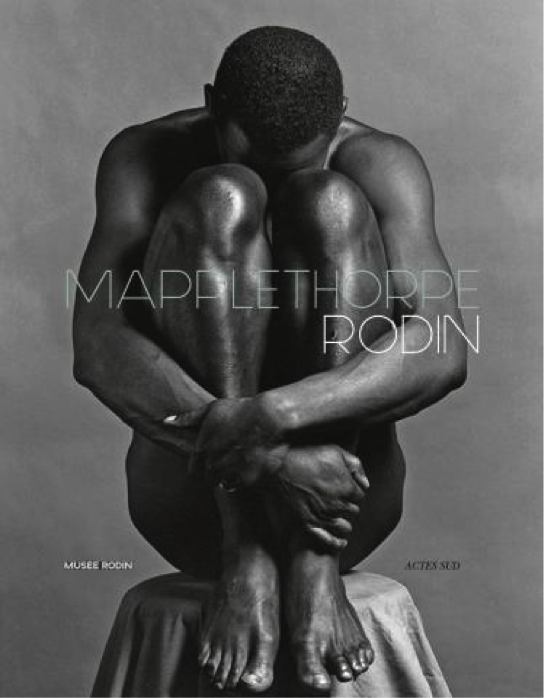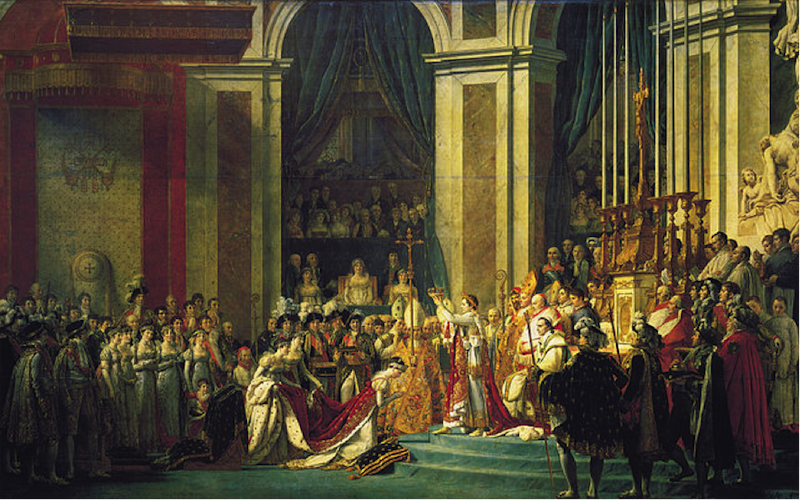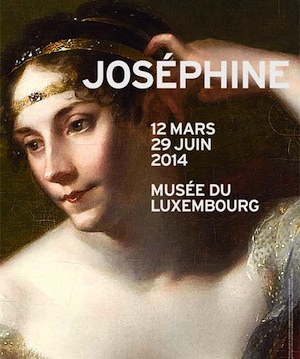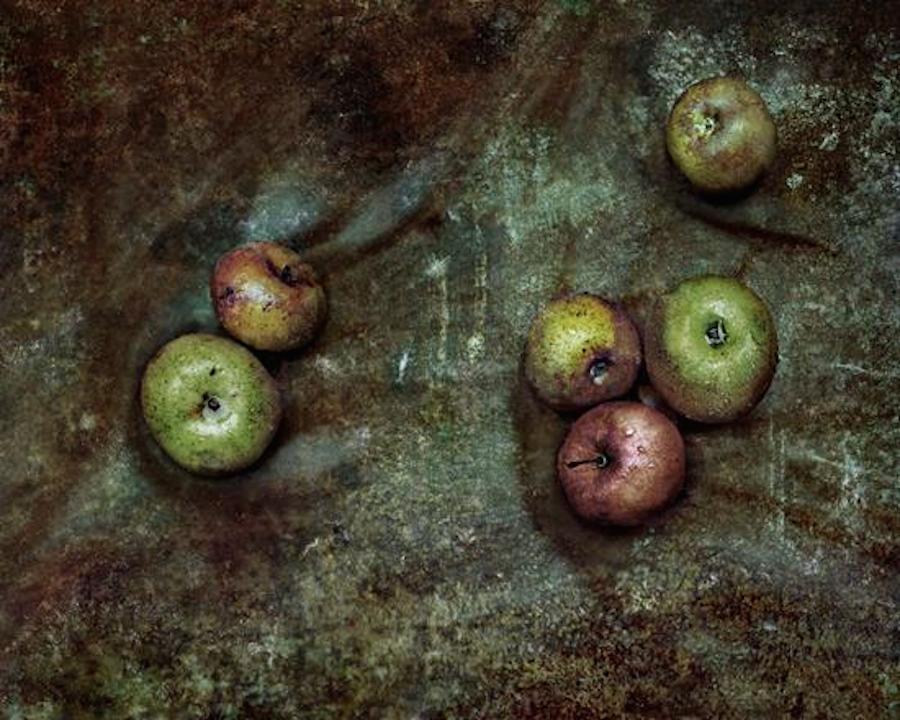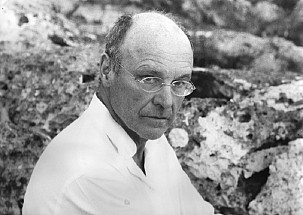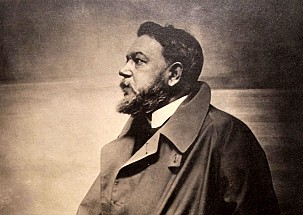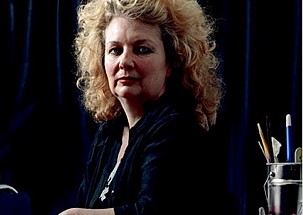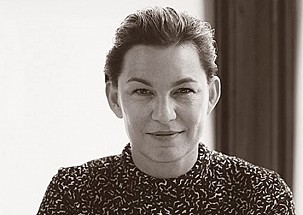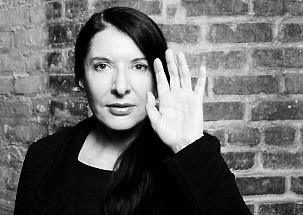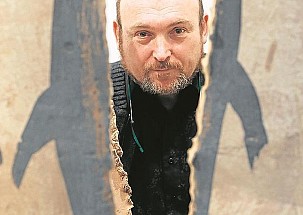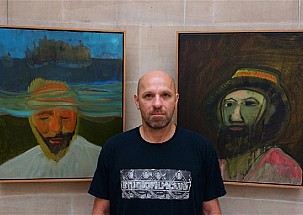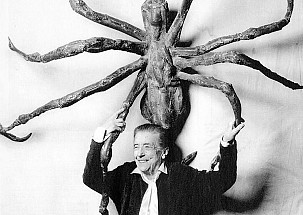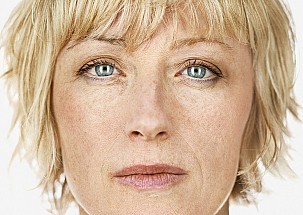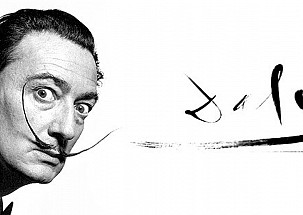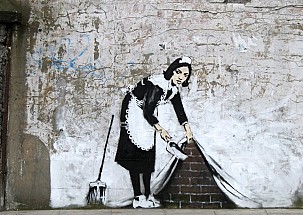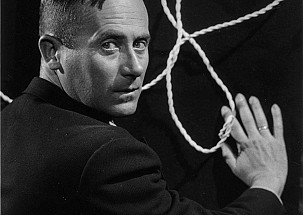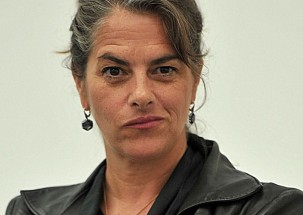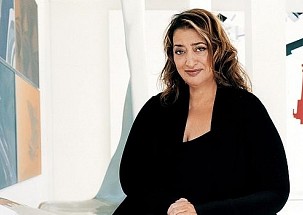- Details
- Written by Maira Herrero
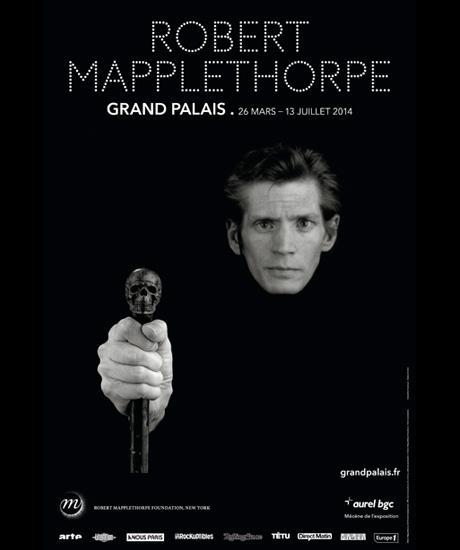
Grand Palais and Musée Rodin. Until July 13.
The city of Paris is commemorating the 25 years since the death of the great New York artist Robert Mapplethorpe (1946-1989) with two exhibitions, at the Grand Palais and Musée Rodin.
The Grand Palais has amassed over 250 works which sum up Mapplethorpe’s life-long career, the different phases it went through, and what was going through his mind when he pressed the shutter release on his Polaroid or Hasselblad. He was obsessed with beauty and with the idea of a world without limits; he studied the power of nature in the human body to give us unforgettable images of faces, hands, naked bodies, as well as a series of photographs of flowers that add a touch of delicacy to his work.
The creative aspect of his photography goes hand in hand with the technical — he was always aware of the latest advances in optical technology and film development. In fact, the exhibition reveals how his film formats evolved through time: from silver gelatin for his first black-and-white images, his colour Polaroids, the photo-engravings of the later years and even his paper- and linen-printed platinum copies. His large-scale formats are key in understanding his image compositions. For the artist in search of perfection, it was the end result that was truly important, not the photograph itself.
Complementary to the Grand Palais exhibition, the Musée Rodin, in conjunction with the Mapplethorpe Foundation, has organized another exhibition with the aim of creating a dialogue between these two great artists. The exhibition consists of 50 sculptures by Rodin together with 102 of Mapplethorpe’s photos, taking visitors on a journey towards the beauty of the human body. Mapplethorpe’s role here is that of an image sculptor: through strongly marked contrasts of light and the refined poses of his models — reminding us of the great Masters of the Italian Renaissance — he achieves an almost otherworldly corporealness.
The heterodoxy of Mapplethorpe’s work has sparked numerous discussions on the limits of art. This retrospective provides a unique opportunity to understand how an American artist who began his career doing collages with other people’s photos eventually became one of the 20th century’s art icons. Through his self-portraits, the artist himself clearly expressed his personal commitment to the search for new worlds, where everything is possible and nothing is forbidden. "I'm looking for the unexpected. I'm looking for things I've never seen before…”
The exhibition at the Grand Palais includes a room with perhaps his best-known works, those of a S&M nature — this room is not accessible to minors. Not that these works are not worth seeing, on the contrary they contain part of the artist’s essence. All his work is full of eroticism, sensuality, subtlety.
An unmissable exhibition! Advanced booking is highly recommended.
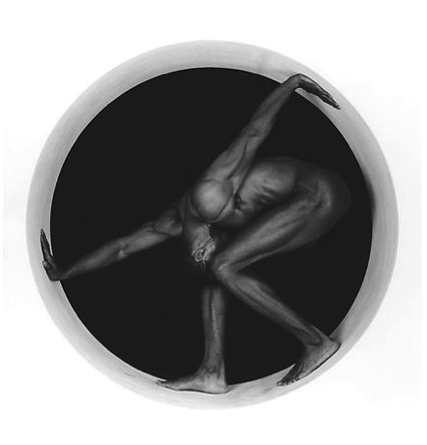
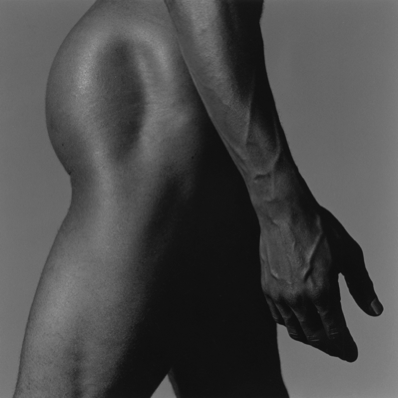
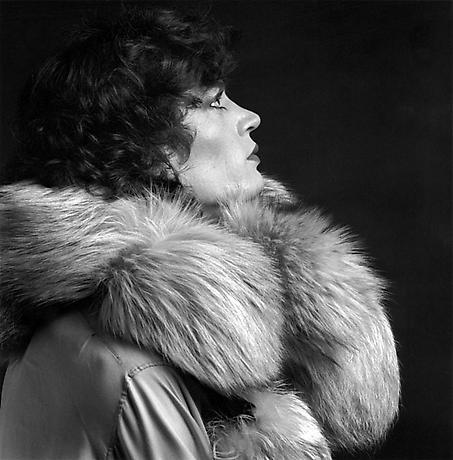
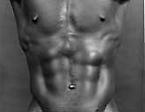
www.grandpalais.fr/en/event/robert-mapplethorpe
www.musee-rodin.fr
- Details
- Written by Maira Herrero
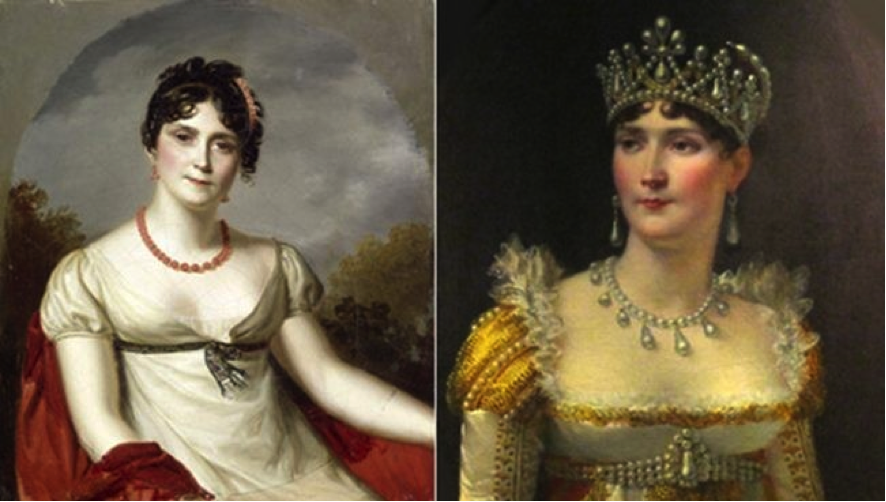
Josephine. Museo de Luxemburgo (Hasta el 29 de Junio)
The Joséphine exhibition at the Musée du Luxembourg — organized to celebrate the bicentenary of her death — is a great opportunity for lovers of classical art.
This exhibition allows visitors to see the different stages of Joséphin’s life, from her time in Martinique, her marriage to Napoleon Bonaparte and coronation as empress in 1804, to her life after her divorce. The music, culture, travels, fashion, gardens and art collecting present in her life are all witness to her progressive lifestyle and her great influence on the modus operandi of French society in the first half of the 19th century.
History fans and francophiles will enjoy a unique walk through the artistic legacy of this temporary empress (1804-1809) who died in 1814. Paintings, sculptures, furniture, ceramics, tableware, jewellery, precious stones and luxurious clothing are all part of this lavish exhibition.
|
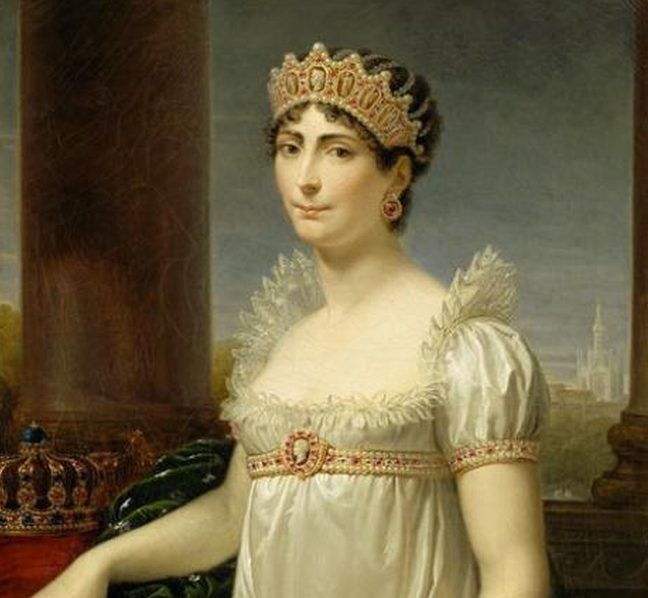
- Details
- Written by Matteo Mottin
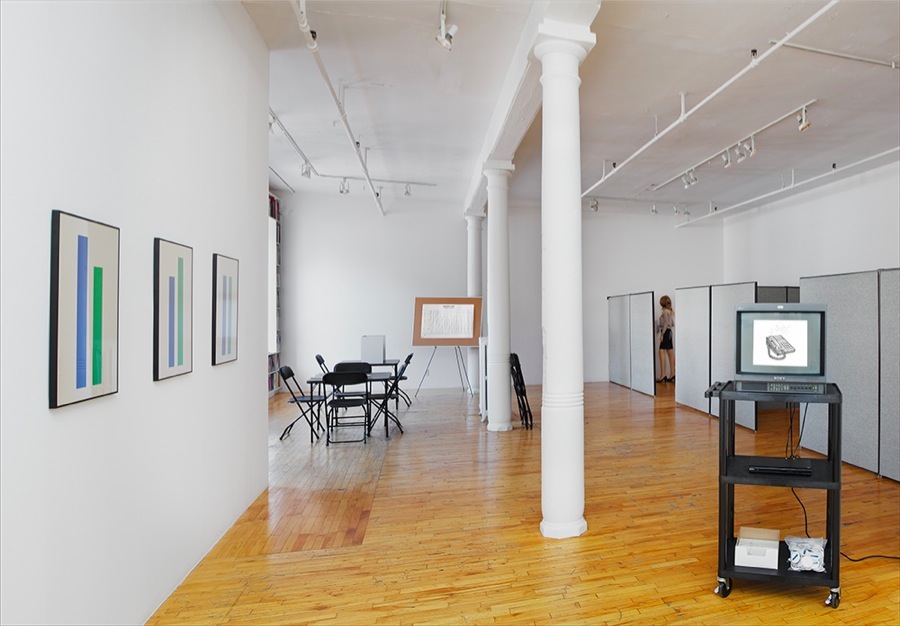
MICHAEL CLIFTON & MICHAEL BENEVENTO AND D´ETTE NOGLE PRESENT REGRESSING TO MEAN – CLIFTON BENEVENTO NEW YORK, 2014 – INSTALLATION VIEW
On April 19th inaugurates “Michael Clifton & Michael Benevento and D´Ette Nogle Present: Regressing to Mean“, the second solo exhibition by D’Ette Nogle (1974, La Mirada, CA; vive e lavora a Los Angeles) with Clifton Benevento.
Her work is often in service of the host and the particular context in which its presented. Among her works, the video “Culturally Relevant Pedagogy,” in which the artist dances with some of her students from Fairfax High School in Los Angeles, putting into practice the assumption that a teacher should learn from the culture of her students in order to develop the right educational practice; in “Reality / Relax” she pays tribute to the structure of Dan Graham’s 1969 “Lax / Relax” performance by reading at home, with her parents, some dialogue transcriptions taken from reality shows. For the 2012 edition of ”Made in LA”, the biennial organized by the Hammer Museum in Los Angeles, she played inside of the museum the bells used during meditation sessions.
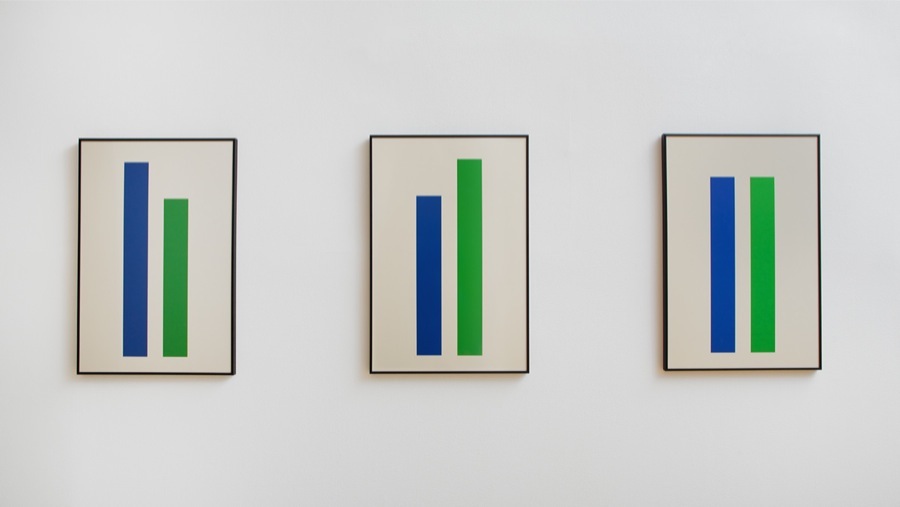
MICHAEL CLIFTON & MICHAEL BENEVENTO AND D´ETTE NOGLE PRESENT REGRESSING TO MEAN – CLIFTON BENEVENTO NEW YORK, 2014 – INSTALLATION VIEW
Matteo Mottin asked some questions to the artist.
Matteo Mottin: Could you tell me about “Michael Clifton & Michael Benevento and D´Ette Nogle Present: Regressing to Mean”? How is it structured?
D’Ette Nogle: The structure supports a testing exercise. Participants take two brief 10-question tests, Form A and Form B. The 10-question test presents visual information and the two answer choices are A) true or B) untrue. As soon as the participant completes Form A, their test is scored and they are informed of their results. Then they will complete Form B. Form B is scored and test-takers are able to determine the change between their results on the two forms of the test. They will know if they: advanced toward the mean, regressed toward the mean, or maintained a consistent position in relation to the mean. The gallery will be organized to support testing by providing an area where participants look at two tableaux that serve as prompts for the first two questions of the test and an area with a table where test-takers may sit and complete the remainder of the test questions. While test-takers wait for their results, they can also make use of a reading table where they may read material from Clifton Benevento’s extensive art library.
MM: “Regressing to Mean” reminds me about my Statistics exams… Why did you choose this title?
DN: First, there is the direct connection to the language of statistics, as you mention, and the idea that when a result is extreme in its first measurement, the second result will be closer to the average. Conversely, if the result is extreme in its second measurement, it will tend to be closer to the average on the first measurement. Also, there is a connection to the other content of the exhibition, the theme of schadenfreude and the potential connection between “meanness” and low self-image on the part of the person feeling schadenfreude. Finally, using elements from my previous show at Clifton Benevento (the office partitions), there is an intentional regression to mean or to communicate a link to my first show at the gallery which is then intended to convey a comparison between the two shows and highlight the vulnerability of the art practice to evaluation or assessment–which is often self-imposed (e.g., “Has she improved or regressed?” or “Have I regressed or is this an improvement?”)
MM: In this exhibition you overturn the common relationship artist-viewer within the exhibition circumstance: here you use a test to give marks to the visitors, and these marks are based on the answers given by a gallery representative. Could you tell me about the reasons behind that?
DN: I see it as an opportunity to consider the typical circumstances that determine how art is viewed and evaluated. In the testing exercise, one person’s subjective answers are compared to another’s, that of Silke Lindner, an employee of the gallery. People working at galleries are often called upon to provide answers to questions about the artist and the art on view. In this case, you have the opportunity to see how your interpretations of the work compare to hers.
MM: You’re using the same grey office partitions you used in your first solo exhibition with the gallery, “Michael Clifton & Michael Benevento and D’Ette Nogle Present: Information from Two Sources” (2012). Besides that, is there any other connection between these two exhibitions?
DN: Each of the two tableaux residing within the office partitions present a scenario, one involving a blonde female and one involving a male. In Information from Two Sources, there was a video within each partitioned space, one presenting the text from an Elle magazine article about the lifestyle of the actress Blake Lively whose role on the series Gossip Girl is characterized in the article as “the perfect escapist heroine for our recession-era daydreams,” and one presenting the narration of a viral video made by an investment publisher named Porter Stanberry called “End of America.” In the video, Stansberry employs fear-mongering and advises potential investors to invest in as much gold and silver as they can afford. Another link to the first exhibition will be a series of three Thematic Posters for Exhibition (Improving, Regressing, Norming). Each of the three will graphically represent improvement, regression, and a consistent relationship to the mean. In the first show, there was an “Investment Opportunity” which presented a portfolio of prints based on scans of my hair, one gold portfolio containing color prints of my blonde hair and one silver portfolio containing black and white prints. I see the “Investment Opportunity” and the Thematic Posters, in their representation of value variations, as an opportunity to consider how art and artists are collected and valued.
MM: This exhibition builds around the notion of schadenfreude, i.e. the joy derived from the misfortunes of others. Why did you decide to deal with this topic?
DN: As a statistical phenomenon, regression toward the mean is also associated with “second-year syndrome” and “the sophomore slump”. I’ve been considering the “sophomore album” and the projections we might be placing on performers or other producers. When we perceive someone’s diminishing success, we may actually be seeking the experience of schadenfreude. When the value judgment is placed on the production of art or some other form of cultural expression, it is difficult to attribute it to the statistical phenomenon or a desire within ourselves. The investment of art largely operates within set conditions that determine value and affect what, by extension, will be valued by others. Within these conditions, it’s difficult to determine what is “true” and what is “untrue.”
Until May 24. The gallery is located at 515 Broadway between Broome and Spring streets, New York. Opening hours are 11am-6pm Tuesday though Saturday.
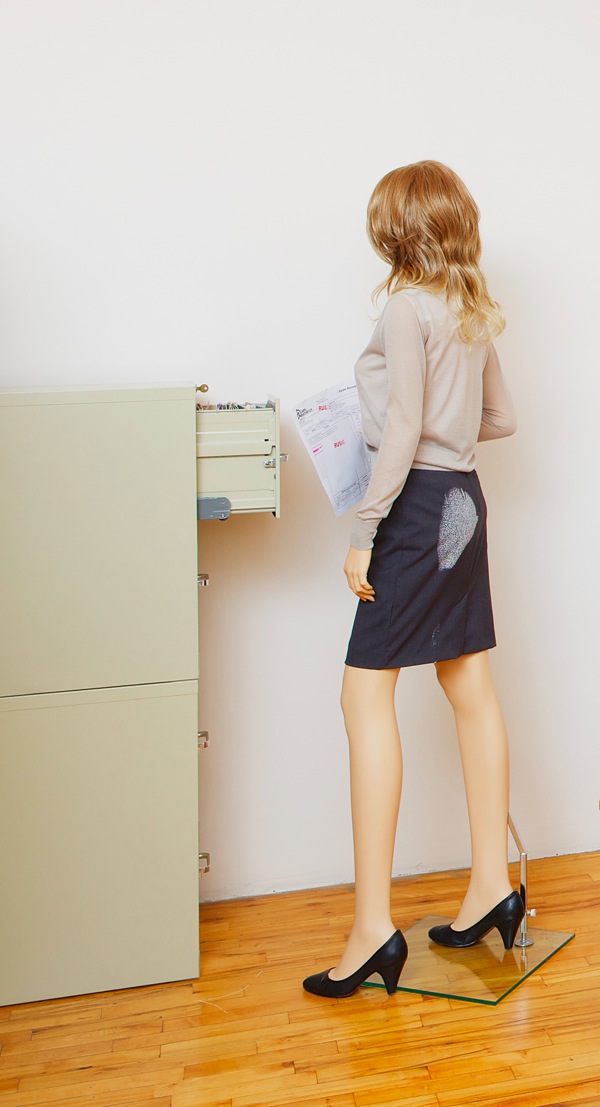
MICHAEL CLIFTON & MICHAEL BENEVENTO AND D´ETTE NOGLE PRESENT REGRESSING TO MEAN – CLIFTON BENEVENTO NEW YORK, 2014 – INSTALLATION VIEW
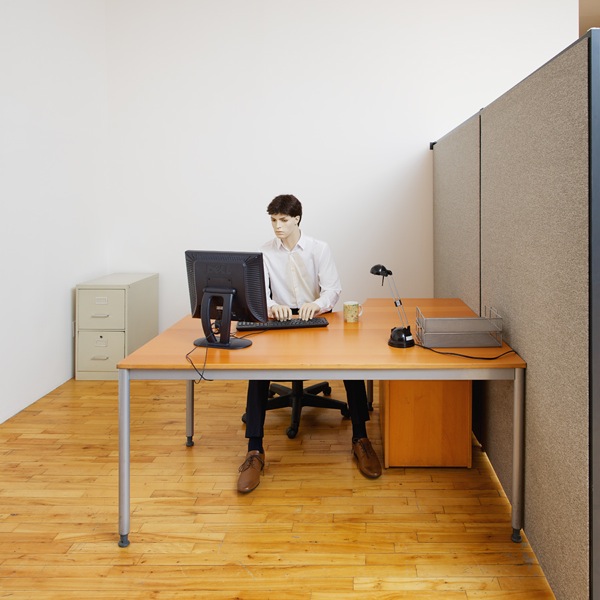
MICHAEL CLIFTON & MICHAEL BENEVENTO AND D´ETTE NOGLE PRESENT REGRESSING TO MEAN – CLIFTON BENEVENTO NEW YORK, 2014 – INSTALLATION VIEW
 |
Written by our friends at ATPdiary.com in colaboration with Matteo Mottin |
- Details
- Written by Maira Herrero
|
Contributor: Maira Herrero, |
 |

My first encounter with the fascinating world of 47-year-old Copenhagen-born Ólafur Elíasson was over a decade ago, in October 2003 in London’s Tate Modern. I found myself before an incredible installation that took up the entire entrance of the museum (Turbine Hall). I was greatly taken aback: light, colour and sound enveloped me so intensely that I actually thought I was seeing a real twilight sun in front of me. Reality and fiction started merging in my head, flinging me and the other visitors in the hall into a whole new dimension of perception. I have been following the artist consistently since then, an artist I consider to be one of the most established in the contemporary international art scene. His artwork, via sensory, imaginative and technical means, offers viewers a range of possibilities for its interpretation.
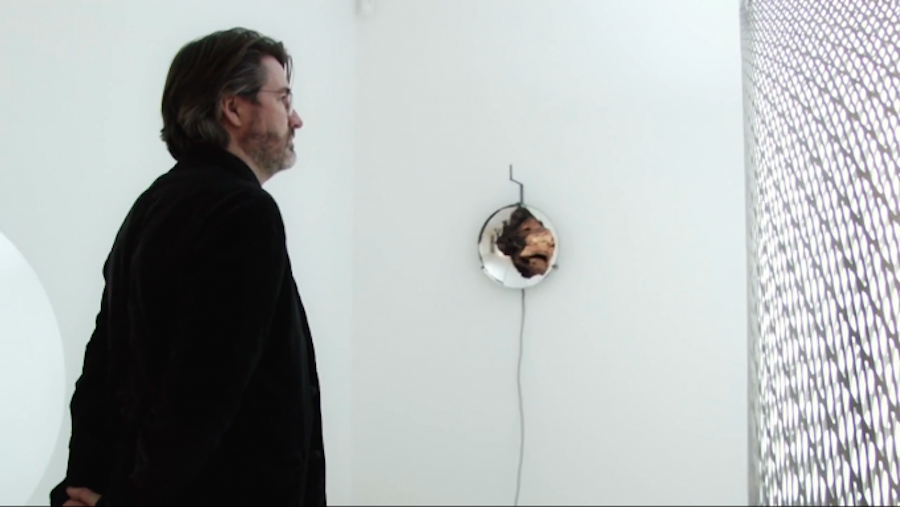
On February 21, Ólafur Elíasson presented his second exhibition, Your Successful Uncertainty, at the Elvira González Gallery in Madrid, the curious title once again representing a nod to the visitor, and a subtle reminder that interaction is a key element of his art. This is not the first time Elíasson starts his artwork titles with the possessive pronoun: Your Uncertain Shadow, Your Blind Movement…
This exhibition is part of Alejandra de Argos’ selection of the Top 10 Exhibitions in Madrid.
The works included in this exhibition are formally very different from one another, yet they all relate to this relationship which is always present in Elíasson’s work: nature as a creative force, and science through method, as answers to life’s endless questions. Elíasson is an explorer in the true sense of the word: he explores and searches through contact with the natural world, which he then represents in his images, such as the ones included in this exhibition (The Hot Spring Series); he picks up pieces of wood on his long walks, transforming them into artworks full of aesthetic and technical meaning (Access Compass); he experiments with everyday materials, such as a decomposing mirror attached by a magnet to a meteorite found in New Mexico; or he reminds us of the importance of water on our planet through an inverted cataract (Waterfall Machine). His works always relate to space as a reflection of movement, light, weather, the experience of life, etc. For Elíasson, the simple act of walking creates space and time (Leer es respirar, es devenir. Escritos de Ólafur Elíasson. GG, Barcelona 2012).
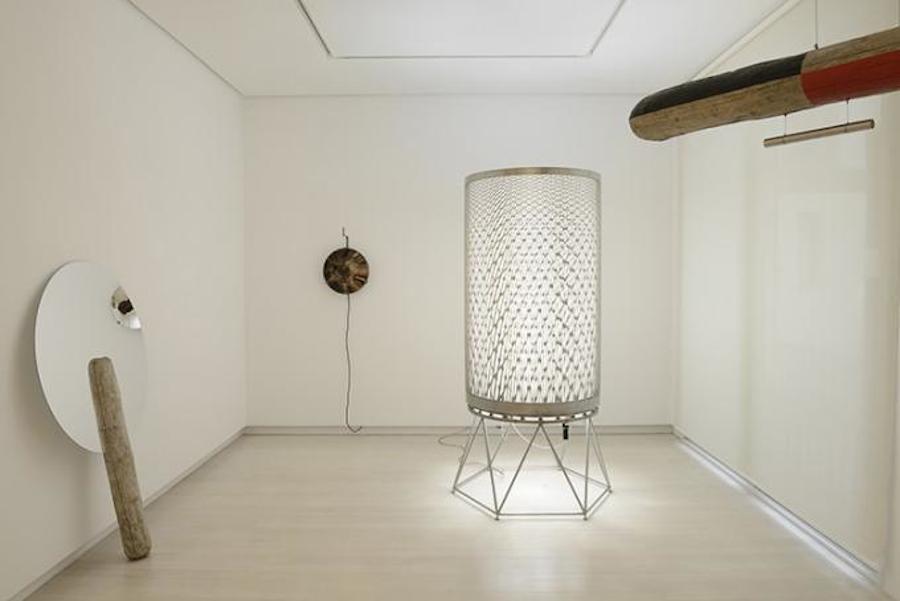
To understand this artist is to understand the reality of our contemporary world. He works with nature to try to unravel its mysteries — he has set up an experimental laboratory in his Berlin studio, where a team of architects, scientists, artisans and art historians help him to execute his ideas, transforming them into the finished pieces that we see in museums and galleries. He is always on the lookout for new ways of merging science and nature, equally interested in both the technical and physical aspects of art, the organic and inorganic. We could say his work can be synthesized as a constant search for the artistic representation of life’s natural phenomena.
His commitment to art extends to education too — Elíasson is also a professor at The Berlin University of Arts. In 2009 he created the Institut für Raumexperimente (Institute for Spatial Experiments), and since then he has been responsible for providing students with his own brand of innovative art education. His comprehensive training approach has led him to take trips with his students in order for them to better understand their relationship with their surroundings. Out of this approach came the Little Sun lamp, a small solar-powered light source that has allowed him to bring light to those remote places of the world that are not connected to the power grid.
When taken as a whole, Ólafur Elíasson’s work is once again a reminder that there can be no meaning in a world without art.
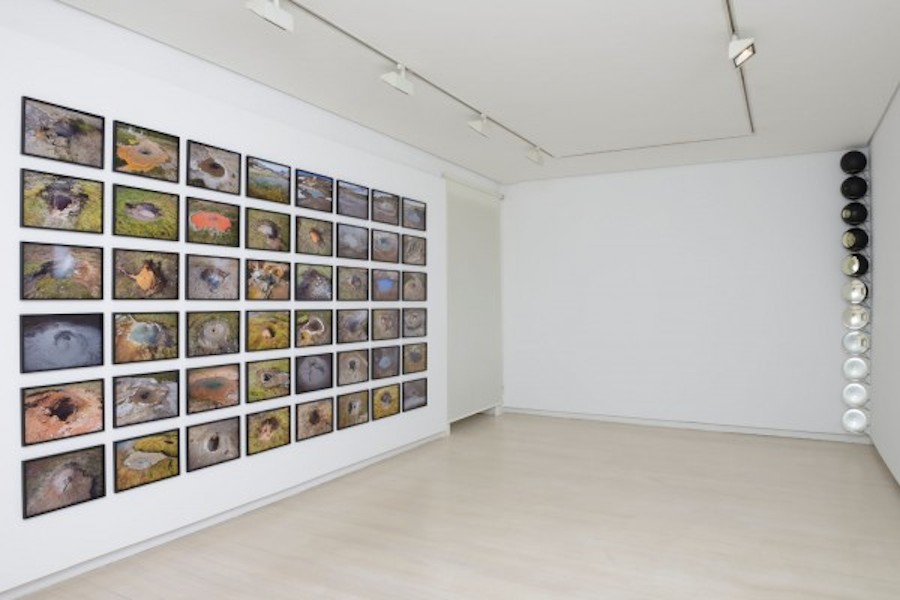
- Details
- Written by Alejandra de Argos
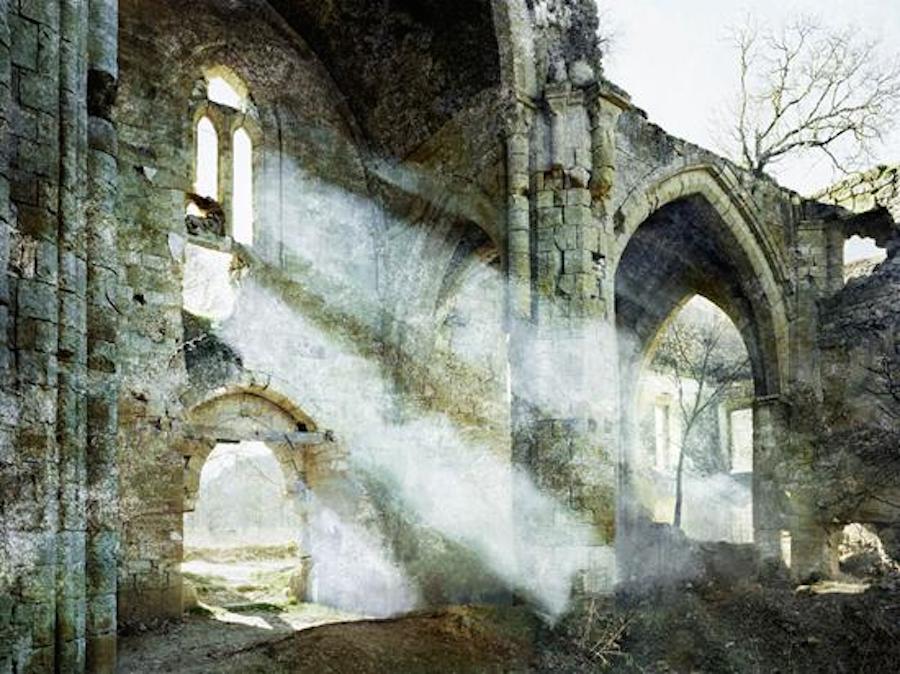
Madrid’s Galería Caylus is for the first time hosting a photography exhibition by a Spanish photographer, Lux Oxidada (Rusted Light) by Fernando Manso (born in Madrid in 1961) — rust and light being the two distinct elements which form the common thread running through the photographs.
Fernando Manso, in this exhibition, is essentially immortalizing select moments that he has managed to capture when certain specific conditions — stipulated by himself — were met, something which at times has made him wait an incredibly long time for the exact moment to present itself.
Other photographs require his own personal intervention, added to the set of natural requirements which he must wait for, in order to obtain just the right balance and harmony that he wants to express to his viewers.
Manso introduces one of his own techniques to the immediacy of the photographic medium: he explained to me that of two copies of a photograph, one is sharp and realistic, and the other is left to suffer the effects of weather, creating an entirely new and beautiful vision of the world.
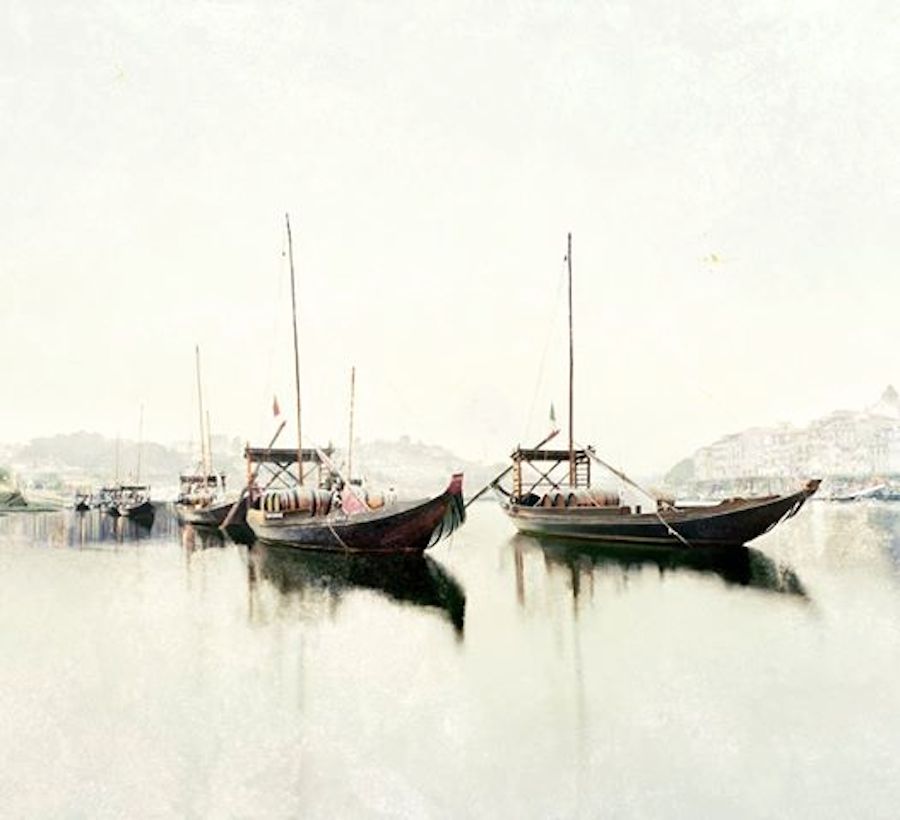
After the camera itself (in this case a camera with bellows for focusing), the next most important element of photography is the vision of the photographer. And then, of course, there’s the level of creativity in the composition.
I loved this exhibition — I found that it truly lived up to the poetry of its title. The peace and loneliness of its landscapes of white veil woods; the cold beauty of the Palacio de Cristal’s glass and metal; the romanticism of its stone monuments, mould and light some, fog and magic others; taverns full of rust and nostalgia, nostalgia suspended in the air all around.
Fernando Manso, a photographer of beauty and of sensations, began his career two decades ago. The attraction, I think, lies in how close photography and painting are in his work. He has edited five books and his photos have travelled in exhibitions around the world. I strongly recommend a visit to the gallery and the ensuing journey that visitors will embark on through his work, the work of a great painter of beauty.
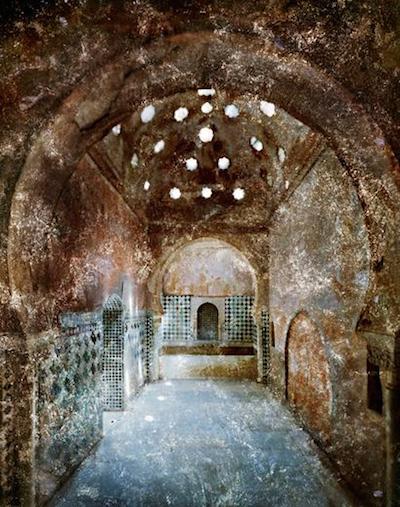
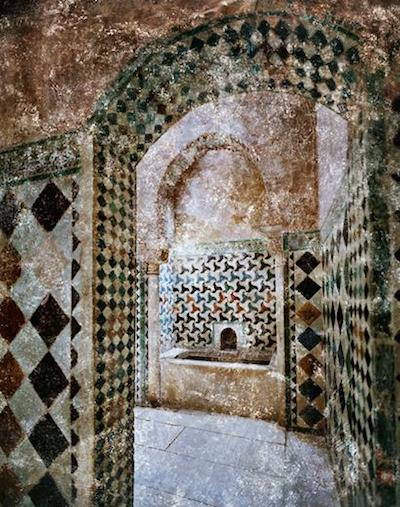
FERNANDO MANSO
"LUZ OXIDADA”
Tuesday, February 11, 2014 - Friday, April 4, 2014
Calle de Lagasca, 28 28001 MadridSpain
- Details
- Written by Alejandra de Argos
Actualizado el 19 de enero de 2015.
10 exposiciones en Madrid que no te puedes perder. Descripciones fotos y videos. Os recomendamos las exposiciones más actuales en Madrid, tanto en museos como en galerías. Visitas indispensables para los amantes del arte en todas sus manifestaciones. Pintura, escultura, fotografía y arte en general. Disfruta en Madrid de las obras y artistas más relevantes. Si te gustan nuestras recomendaciones, guarda este enlace, pues actualizamos periódicamente nuestra guía de exposiciones en Madrid.

Mujeres de Roma
Hasta el 14 de febrero
En colaboración con el Museo de Louvre, Caixaforum nos trae una exhibición que explora la forma en que la mujer es representada en las villas romanas en una época en la que si bien la mujer jugaba un rol reducido o inexistente, tenía un papel muy importante en el entorno doméstico de la sociedad.
![]()
CentroCentro Palacio de Cibeles

Kandinsky. Una Retrospectiva
Hasta el 28 de febrero de 2016
Una de las mayores presentaciones del teórico del arte y pintor ruso Wassily Kandinsky que se han hecho en España. La carrera del influyente artista de vanguardia se explora a través de cerca de 100 de sus obras. La exhibición se aproxima a la trayectoria de Kandinsky pasando por sus primeros años en Alemania, luego en Rusia y finalmente en Francia.
![]()

La Oficina de San Jerónimo
Hasta el 27 de marzo de 2016
Los 17 retratos de San Jerónimo en esta exhibición subrayan la relación de la pintura con la literatura, haciendo homenaje a las formas literarias. Las obras son provenientes de colecciones privadas y públicas francesas y españolas, incluyendo el Museo del Prado. La exposición, comisariada por Fabienne Di Rocco y Eduardo Arroyo, es el resultado del trabajo de cuatro años y medio que ha tomado conseguir las piezas.
![]()

Ignasi Aballí. Sin Principio / Sin Final
Hasta el 14 de marzo de 2016
El artista contemporáneo Ignasi Aballí nos hace reflexionar sobre la percepción de diferentes medios artísticos como la pintura, la fotografía, el cine o el vídeo por medio de esta exhibición. El artista comenzó su carrera en los años 80s y desde entonces ha tenido una aproximación conceptual a las formas y técnicas artísticas que componen su propia expresión.
![]()

Alex Katz: Portraits
Hasta el 5 de febrero
Alex Katz es un artista figurativo estadounidense trabaja con varios medios como lo son la pintura, la escultura y el grabado. Alcanzó importancia pública en la década de los 80s. Es conocido especialmente por sus pinturas de gran tamaño y su particular simplicidad. Su arte es ahora entendido como precursor del arte pop.
![]()

Dan Vō
Hasta el 28 de marzo de 2016
Danh Vō es un artista conceptual de Vietnam que trabaja en Berlin. El artista suele explorar ideas sobre identidad utilizando documentos, esculturas, fotografías y en varios casos apropiaciones de las obras de otros artistas. Danh Vō utiliza la particular arquitectura del Palacio para esta particular exhibición.

Nueva Babilonia
Hasta el 29 de febrero de 2016
Constant Niuwenhuys fue un artista holandés cuya obra se manifestó a través de la pintura, la escultura, el arte visual y la música. Su trabajo es, como el mismo lo describía, una sugerencia lanzada al público para provocar. Esta exhibición cuenta con unas 150 de sus obras por medio de las cuales se pretende presentar a la ciudad utópica de Nueva Babilonia como obra de arte.
{youtube}s13Y4NznzDs|600|350{/youtube}

Ingres
Del 24 de noviembre al 27 de marzo de 2016
El Museo del Prado presenta en colaboración con el Louvre una retrospectiva cronológica de la obra del pintor francés neoclásico Jean-Auguste-Dominique Ingres. La exposición se enfoca particularmente en la relación del artista con la técnica del retrato y la contrasta la idea que el artista tenía sobre sí mismo como un pintor de historia.
{youtube}BEB0JNGD98U|600|350{/youtube}
Exposiciones Madrid
Pensamos que el arte no está reservado a unos pocos, es universal y comunica un extenso mundo que ofrece innumerables opciones y talentos en todas las expresiones.
Madrid posee una enorme riqueza en museos, galerías, salas de arte, con solo mirar a nuestro alrededor, podemos observar que hasta en las calles madrileñas, se puede ver un destello arquitectónico artístico.
Hay demasiadas cosas para ver, comentar y descubrir, en la apasionante metrópolis. Exposiciones Madrid se hace eco de la historia, actualidad y futuro, de la gran ciudad, dado el patrimonio cultural que la rodea, digno de conocer y redescubrir.
Galerías de arte, museos, artistas, salas de arte, instituciones culturales y diversas entidades, promocionan la pintura artística, una expresión viva y actual. Una ciudad emblemática que constantemente se expresa, cautivando a los miles de visitantes que disfrutan del arte en plenitud. Exposiciones Madrid propone citas impostergables, para los turistas o residentes que quizá sin saber de arte, reconocen el gran valor de las obras que alberga la capital y los más versados en el tema aprecian, los grandes tesoros que conserva.
La pretensión de la página, es aportar humildemente, recomendaciones sobre lo que para mí son las diez mejores exposiciones de arte en Madrid , siempre actualizándolas para mantenerlas al día.
- Details
- Written by Calíope Garmendia
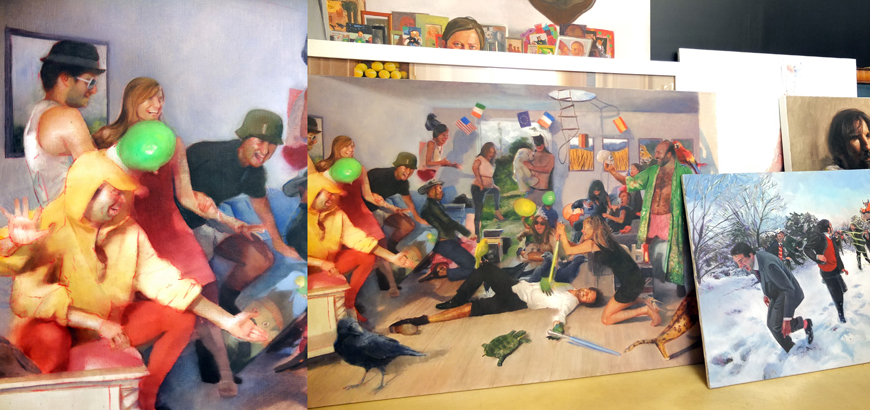
You don’t make a such a discovery every day. Not long ago I picked up a random stranger, unknown to most, with a growing influence on national art circles. My encounter with him happened out of pure chance, but that’s a whole other story. His name is Íñigo Navarro.
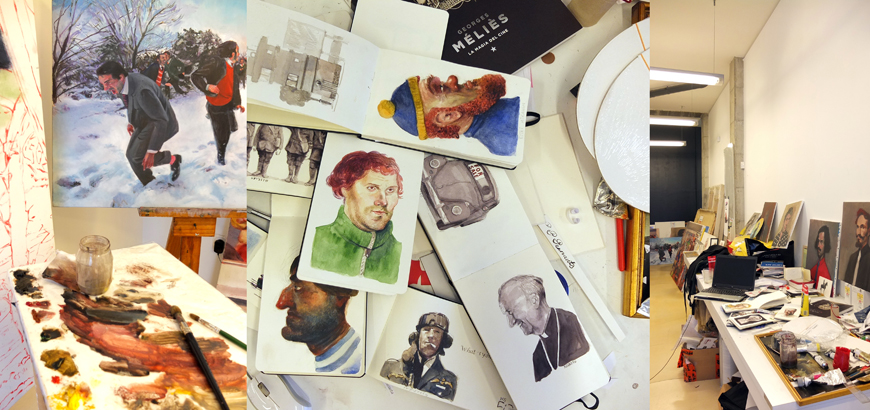
Here’s the conversation we had in full: it’s certainly worth a read.
“May I come in?”, I said timidly from the corner of the studio.
“Just a moment, I’m getting dressed!”
“Oh goodness me, ‘getting dressed’?”. Navarro appeared a couple of minutes later wearing a leopard-skin dressing gown and a dazzled expression.
“Holy Mary, you’re beautiful! Are you a goddess?” Before answering him, I grabbed the can of pepper spray that I always carry in my jacket. He looked harmless enough, but you can never be completely sure with artists.
“Well… I’m Calíope, Calíope Garmendia.”
“And what have you come here for, Calíope Garmendia?”
“I was curious, I wanted to find out more about you and your work. What were you doing there naked, anyway?”
“I was exploring my body.”
“OK, never mind…”
“Oh no, no no no, it’s not what you think… I have a friend who’s a performance artist… How can I put this? He undresses in inappropriate places, like the men’s toilet of a bar — there’s always someone who gets angry and ends up attacking him. He then goes back to his studio and takes photographs of his wounds. He puts the photographs together in series of five and sends them off to his gallery in Cologne, who pay him handsomely for them. He believes that an artist simply resides in a body, and that knowledge of one’s own body is absolutely essential. I personally am very interested in the conceptual relevance of my work, which is why I spend a lot of time carefully studying each single element of them.”
“This friend of yours seems interesting, perhaps I could interview him too.”
“Of course — I’ll put you two in touch as soon as he’s out of the hospital.”
“What? On second thought, forget it, let’s get down to business. I want to talk about you. I can see that your studio is full of your work, and some pieces are very large. For example, how big is this one over here?”
“Three metres tall. Actually, I think it’s too small. I’m preparing a large event in Ávlia, with more than a hundred models, and I want to have the models in the foreground look like they’re life-size. This means that my next painting will need to measure four metres by eight.”
“The models will be in fancy dress, right?”
“It’s a ceremony, an interpretation of the exotic cruelty that’s all around us. Would you like to take part?”
“Not for now, thanks. Could you tell me more about these anthropological digressions you just mentioned?”
“Of course. What I meant was that we still celebrate the bloody bull runs of Pamplona, we send enxanetas to the top of the Castells (human towers) without fear of their death, atheists shed tears accompanying the Macarena, we walk bare-foot over burning coals, parents happily buy their children fireworks to celebrate the mascletades, among many other peculiarities.”
“Spain has changed a great deal.”
“It’s certainly true that we have changed, and we’re many other things now, but these other things, which can in fact be found everywhere else in the world, don’t interest me as much. Nor do I think they are particularly interesting from an artistic point of view. This is exactly what globalization in art is about, a conceptual homogeneity that is terribly harmful to creativity.”
“Is this why you paint?”
“Actually, yes. Spanish painting education is world-renowned. If we can learn something from the relentless tautology that is contemporary art discourse, it is that there is no technique that is superior to others. By choosing painting over newer artistic media, I do away with all the showy, technological factors that new media bring with them, and in so doing I can get straight to the core idea that I want to express. And paradoxically, I also distance myself from institutional tendencies, from contemporary academicism.”
“What is that idea?”
“Fatality. Whatever we may do in life, we end up dead. I’m interested in everything we do to fill our days until our time comes to die. Deciding to occupy one’s time with such an old activity as painting can be considered a joke or something extremely important — it’s ambiguous. I personally don’t fear death.”
“Really?”
“Of course not; I’m convinced that death is not final. In fact, I can prove it to you mathematically. Would you like me to show you?”
“No, thank-you! By saying that “death is not final”, are you not contradicting your beliefs in fatality?”
“Well… no. I’m generalizing. Here in the West, we are living in the best time that we’ve ever seen, yet I think we can see symptoms of decadence. Materialism is the new God, and this brings its own dangers. People’s greatest fear is death. This has never happened before in the history of humanity, and its consequences on our daily lives — let alone on art — are far more serious than we think.”
“Are you saying, then, that belief in God is a prerequisite for creating great art?”
“No, certainly not, but it does help. You can’t just make something exceptional by sitting around. You need to invest many hours of hard work without the certainty that you will be rewarded with a great piece of work. Some kind of faith — any kind, it doesn’t really matter which — is required in order to overcome this phase without falling into materialist temptations. Would you like a coffee?”
“No, thanks.”
“I’ll put one on for myself, if you don’t mind.”
“Many artists find it difficult to talk about their work, but you don’t seem to have any trouble doing so.”
“On the contrary, I love talking about the work I do. I spend hours on the phone talking to my colleagues about art, like an excited teenager. Perhaps something I don’t do is explain my work in detail. The only way I can explain my work is by exhibiting it. I create my work for it to be shown — that is how it reaches its expressive peak. At one of my exhibitions, Scope London, a gentleman from Bristol got so emotional at the sight of one of my photos that he couldn’t help but relax his sphincter muscles.”
“Oh my goodness.”
“He farted so loudly that he ended up buying two photographs”.
“Disgusting!”
“Poor man. I have never felt so honoured by a visitor’s reaction to my work as I was then.”
“Who are your references?”
“In terms of writers, Conrad, Kennedy Toole, Sharpe, Amélie Nothom. In terms of artists, I’d single out two, among the many that I like: Velázquez — not only for his clear technical ability, but also for his sensitivity and worldliness — and Antonio López, for what he taught me in his workshop and for being a true artist, full of energy and love towards painting. If I had to pick a soul-mate in the art world, I’d choose Berlanga, the late film director, God bless him.”
“A film director!”
“Berlanga was a genius story-teller, without ever taking away the mystery that is always present in a work of art. That’s my leitmotiv: to express myself, and to be understood, without losing the magic.”
“What are you working on now? What will you do with all this work in the studio?”
“What you see here are four years of research. In these four years I have tried to understand what it is that I do best, and how to express it. It’s a complex and ambitious project, and I aspire to immortality.”
“You’re certainly not modest, are you?!”
“Quite!”
“It’s been a pleasure.”
“The pleasure is all mine. It’s rare to be visited by one of the nine muses from the distant city of Argos.”
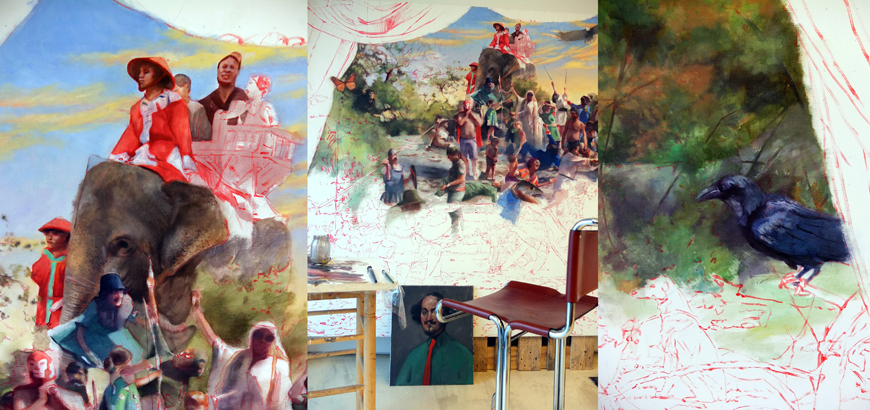
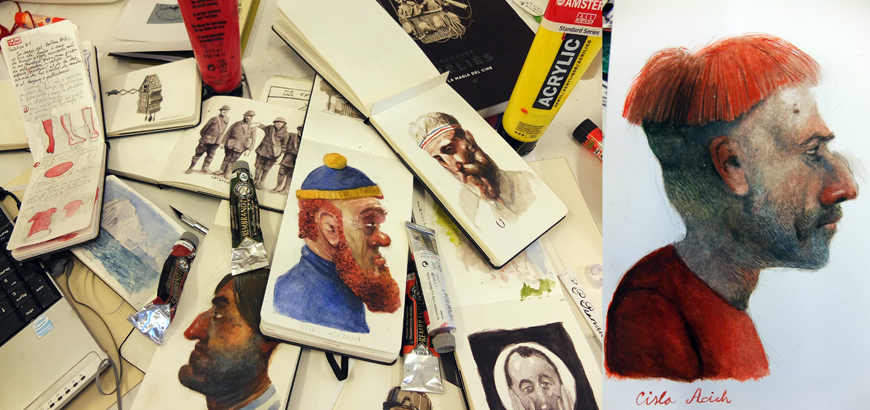
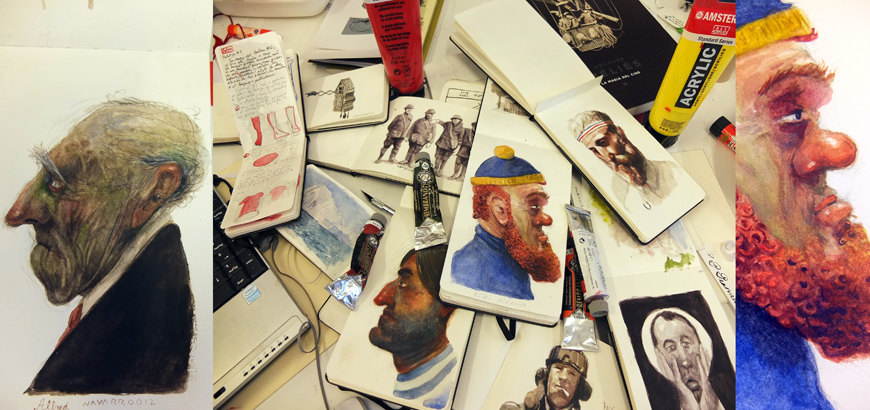
To learn more about this fascinating artist, visit www.inigonavarro.es.


